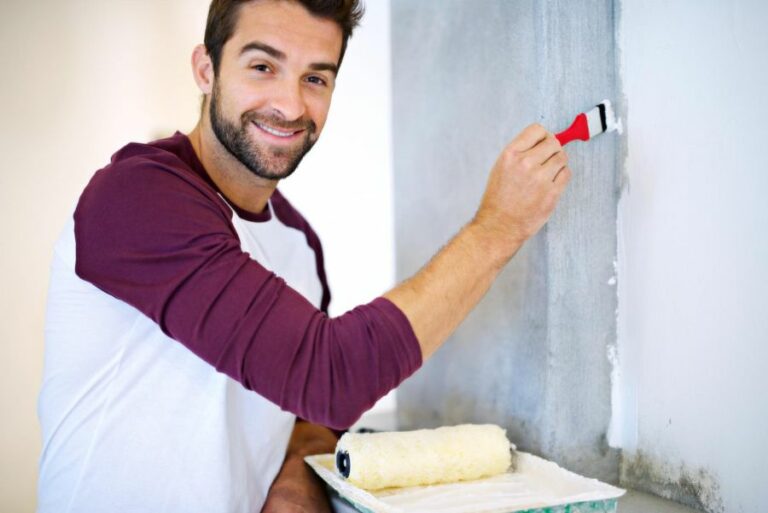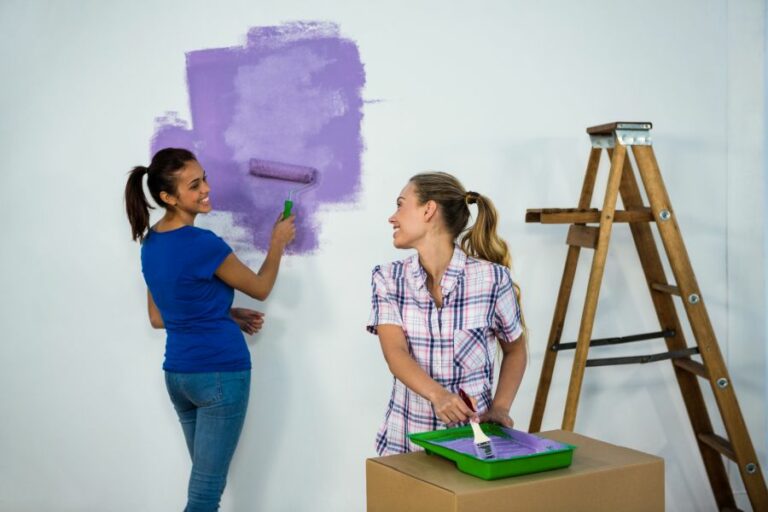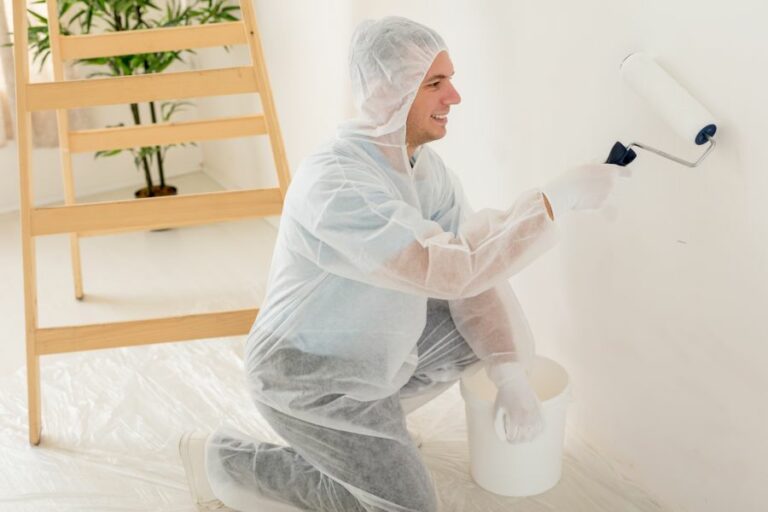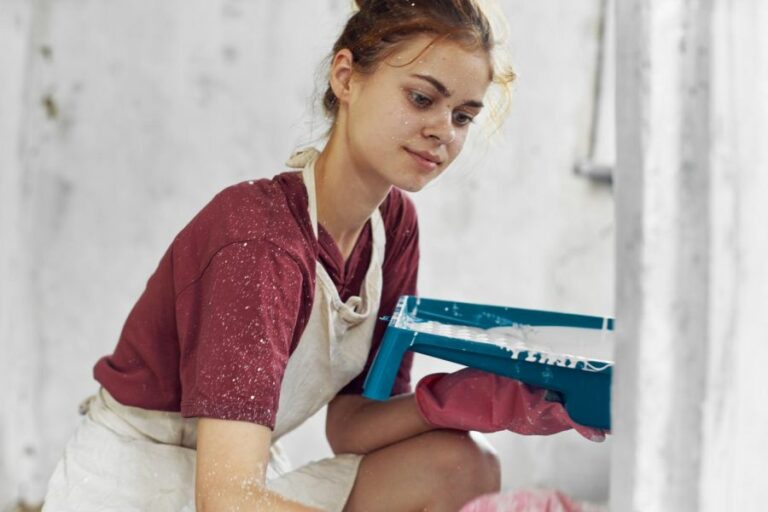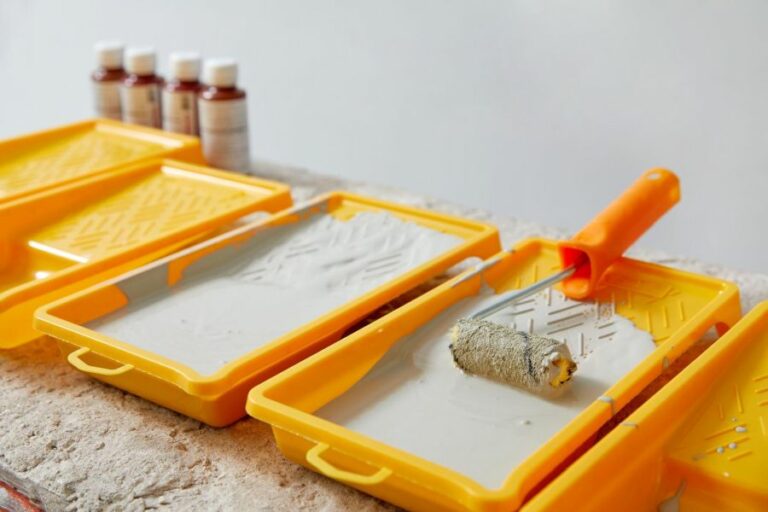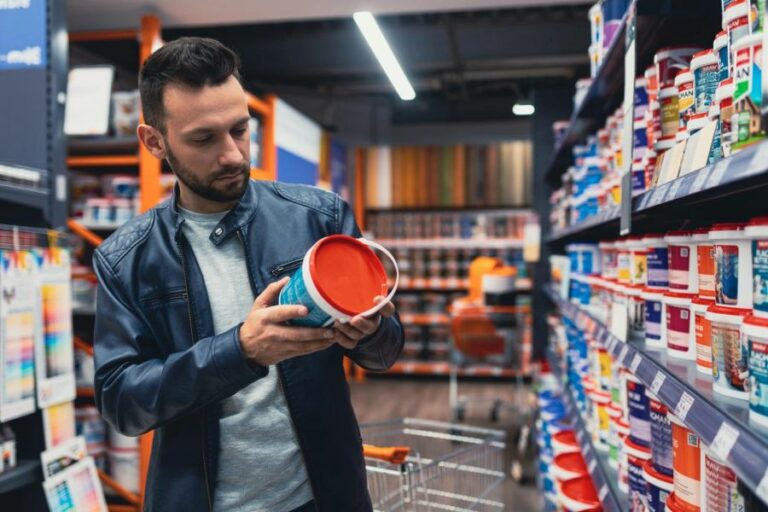Interior Paint That Resists Water Damage. What Pros Say
Do you struggle with water damage on your interior walls? There’s a solution to that! I have the perfect interior paint that can resist water damage and give you the peace of mind you deserve. Join me as I dive into the details and let your walls enjoy a fresh, lasting finish.
Interior paint that resists water damage:
Water-resistant interior paints, such as latex, acrylic, and elastomeric paints, offer varying levels of protection against water damage, preventing mold, mildew, and structural issues. They are easy to clean, durable, and can increase property value. Ideal for bathrooms, kitchens, basements, and laundry areas, these paints help maintain a home’s appearance and integrity.

Discover the revolutionary interior paint that resists water damage, protecting your home from potentially costly repairs. Unveil its unique features, benefits, and application process that make it an essential addition to any DIY or professional painting project.
Dive in and learn more about this game-changing product!
Contents
- 1 Water-Resistant Interior Paint Options
- 2 Water Damage-Preventing Paints
- 3 Best Waterproof Interior Wall Paints
- 4 Interior Paints for High Humidity Areas
- 5 Most Durable Interior Paint Selection
Water-Resistant Interior Paint Options
• The Importance of Water-Resistant Interior Paints
Water damage is a common problem that most homeowners will face at some point. It can lead to issues such as mold, mildew, and structural damage that can be costly to repair. Choosing an interior paint that resists water damage is essential to protect your walls and enhance their longevity.
• Types of Water-Resistant Paints
There are several types of water-resistant paints available in the market. Each type offers a different level of protection against water damage. Here are the most notable ones:
- Latex Paint: Latex paint is water-based and provides a mild level of water resistance. It is easy to clean, dries quickly, and offers good adhesion to various surfaces. (source)
- Acrylic Paint: Acrylic paint is also water-based but offers better water resistance than latex paint. It is more durable, long-lasting, and less prone to cracks or peeling.
- Elastomeric Paint: Elastomeric paint is a high-quality paint that offers the highest level of water resistance. It is a thick, elastic coating that can fill and cover small cracks and crevices in walls, offering excellent protection against water damage.
• Benefits of Water-Resistant Paints
Water-resistant paints offer several key benefits that make them an excellent choice for any home or building. Some of these benefits include:
- Protection Against Moisture Damage: By using water-resistant paint, you provide a barrier between your walls and moisture, which helps prevent mold, mildew, rot, and other forms of water damage.
- Easy to Clean: Water-resistant paints are generally easier to clean than standard paints, making it simpler to maintain a fresh, clean, and attractive appearance in your home.
- Durability: Water-resistant paints often last longer than standard paints since they are designed to withstand the harsh effects of moisture and water.
- Increased Property Value: Protecting your home from water damage can help maintain its value over time, making it a smart investment when looking to sell or rent your property.
• Practical Applications of Water-Resistant Paints
Here are some common areas in your home where using water-resistant paints can be particularly beneficial:
- Bathrooms: Bathrooms are often the most humid and moisture-prone areas in your home. Water-resistant paint can help prevent mold and mildew in these spaces.
- Kitchens: Kitchens are another area where water-resistant paint can be beneficial, particularly near the sink and cooking areas where moisture may accumulate.
- Basements: Basements are prone to water damage from groundwater seepage, humidity, and other factors. Using water-resistant paint can help protect your basement’s walls from damage.
- Laundry Areas: Water-resistant paints are beneficial in laundry areas as they can come into contact with moisture from washing machines and drying clothes.
• How to Choose the Best Water-Resistant Paint
When selecting a water-resistant paint, consider the following factors:
- Level of Water Resistance Needed: Assess how susceptible the location is to water damage to determine the appropriate level of water resistance required.
- Paint Sheen: Glossier sheens are generally more water-resistant and easier to clean compared to flat finishes. However, they may also highlight surface imperfections.
- Application Process: Ensure that you correctly apply the water-resistant paint according to the manufacturer’s instructions to guarantee optimal results.
- Price: Higher quality and more water-resistant paints may be more expensive. However, investing in better-quality paint can save you money on future repairs and repainting.
- Color and Style Preferences: Choose the paint based on your preferred color and style while ensuring it meets the water resistance criteria required for your space.
• In Conclusion
Investing in high-quality, water-resistant interior paint is an essential step in protecting your home from potential water damage.
By carefully considering the types of water-resistant paints, their benefits, practical applications, and selection criteria, you can make an informed decision and choose the best option for your needs.
Maintaining your home’s appearance, value, and structural integrity is worth the investment in water-resistant paint.
Water Damage-Preventing Paints
If not addressed immediately, water damage can wreak havoc on your home or building. Applying the appropriate paint is one effective way to protect your property from water damage.
• Understanding Water-Resistant Paints
Water-resistant paints are formulated to create a barrier preventing water intrusion. This makes them an ideal choice for surfaces exposed to moisture or occasional water seepage. These paints come in various types, offering different degrees of protection against water damage.
– Acrylic Paint
Acrylic paint is a popular water-resistant paint choice because of its versatility and affordability. It is a water-based paint made from acrylic resin, making it durable and resistant to water damage.
Acrylic paint can be applied to various surfaces like wood, concrete, and metal. In addition, they are easy to clean up and maintain.
– Epoxy Paint
Epoxy paint is a two-component paint system that forms a hard, durable surface when mixed. As a result, it provides excellent water resistance and protection against chemicals, abrasion, and stains.
Epoxy paint is commonly used for industrial and commercial applications but can also be employed in residential settings with damp conditions.
– Elastomeric Paint
Elastomeric paint is a high-quality water-resistant paint composed of elastic polymers, allowing it to stretch and contract with temperature fluctuations. This property helps bridge hairline cracks and keep water out while maintaining a durable, flexible coating.
Elastomeric paint is ideal for areas prone to cracking and water penetration, such as exterior walls, roofs, and basements.
• Factors to Consider When Choosing Water-Resistant Paint
To determine the best paint to prevent water damage, consider the following factors:
– Surface Material
Different surfaces require specific paint formulations. For example, acrylic paint works well on wood or drywall, while epoxy paint is better for concrete and metal surfaces.
– Location
The location of the painted surface should also influence your choice. For exterior areas prone to water infiltration, elastomeric paint is a good option. Indoor spaces with exposure to moisture, such as bathrooms or basements, would benefit from epoxy or mildew-resistant acrylic paint.
– Maintenance and Durability
Paints with higher durability will require less maintenance and last longer, protecting your surfaces from water damage more effectively. Epoxy and elastomeric paints offer excellent durability, while acrylic paint may need recoating more frequently.
– Environmental Impact
Environmentally friendly paint options, such as Low or Zero-Volatile Organic Compounds (VOC) paints, should be considered to minimize potential health effects and contribute to a greener environment.
• Expert Recommendations: Paint Choices to Prevent Water Damage
Based on personal experience, the following water-resistant paints are recommended for various applications:
- For exterior walls: Elastomeric paint provides excellent waterproofing capabilities and durability, preventing water ingress and mitigating potential damage.
- For interior walls and ceilings: Acrylic paint with added mildew resistance is recommended for rooms with moisture exposure, like bathrooms and basements.
- For concrete and metal surfaces: Epoxy paint offers exceptional water resistance, durability, and protection against chemicals and abrasion, making it suitable for both residential and commercial applications.
• Application Tips for Water-Resistant Paints
Proper application is essential to ensure the effectiveness of water-resistant paints in preventing water damage. Here are some useful tips:
- Surface preparation: Thoroughly clean and dry the surface, removing any loose paint, dirt, or grease. Repair cracks and holes to create a smooth, even surface.
- Priming: Apply a suitable primer to ensure better adhesion and enhance the paint’s water-resistant properties.
- Appropriate paint application: Follow the manufacturer’s instructions regarding the number of coats, application methods, and required drying times.
- Regular maintenance: Periodic inspections, cleaning, and repainting when necessary will prolong the paint’s protective properties and prevent possible water damage.
• In Conclusion
The best paint to prevent water damage will depend on the surface material, location, and other factors. Acrylic, epoxy, and elastomeric paints all offer water-resistant properties, but it’s crucial to choose the appropriate paint for your specific needs.
In addition, proper preparation and application are essential in ensuring the paint effectively protects against water damage. So, select the right paint and follow expert recommendations to ensure your home or building remains safe from potential moisture-related damage.
Paint Type | Description | Benefits |
|---|---|---|
Acrylic Latex Paint | Water-based paint that combines acrylic resins with latex | Low VOCs, easy clean up, long-lasting, and resists mildew |
Elastomeric Paint | Thick, flexible, waterproof paint made from polymer components | Waterproof, bridges small cracks, UV resistant, and provides excellent coverage |
Masonry Paint | Water-based paint, which is designed for use on concrete, brick, and stucco surfaces | Resistant to water and alkali damage, breathable, and easy to apply |
Concrete/Deck Paint | Designed for use on concrete, wood, or masonry surfaces | Protects against water, mold, mildew, and weather damage |
Best Waterproof Interior Wall Paints
Waterproof paint is an essential consideration for maintaining the integrity of your home’s interior walls. Water damage can lead to costly repairs, and using the right paint to protect against moisture can save you time and money in the long run.
• Understanding the Importance of Waterproof Paint
Water damage in the interior of a home can occur from various sources – leaks in roofs, pipes, and windows or from humidity that accumulates in poorly ventilated areas.
In order to prevent moisture infiltration and the resulting damage to your home’s structure, it’s essential to choose the right type of waterproof paint.
By acting as a barrier to moisture, high-quality waterproof paint can prevent problems such as mold and mildew, rotting wood, and peeling paint. Moreover, protecting your walls from water damage ensures the longevity of your home and maintains its appearance and value.
• Types of Waterproof Paint for Interior Walls
There are several types of waterproof paint on the market, each with varying degrees of effectiveness and application suitability.
– Acrylic Paint
Acrylic paint is a popular choice for interior walls because of its durability and easy application. It has a higher resistance to water, making it a suitable option for lightly damp areas such as bathrooms and kitchens.
However, it is not generally considered the best option for high-moisture areas or situations with active water leaks.
Pros:
- Durable
- Easy application
- Suitable for light moisture areas
Cons:
- Not ideal for high-moisture areas or active leaks
– Elastomeric Paint
Elastomeric paint is a superior waterproofing solution compared to acrylic paint. It is a thicker, more durable paint that forms a waterproof barrier on the walls. Elastomeric paint is particularly useful in situations where water intrusion is a concern, such as basements or rooms with a history of leaking.
Pros:
- Superior waterproofing
- Durable
- Effective in areas with water intrusion concerns
Cons:
- Can be more difficult to apply due to the thickness
– Cementitious Waterproofing Paint
Cementitious waterproofing paint is a mixture of Portland cement, aggregates, and special waterproofing additives. It is designed specifically for extreme water exposure areas such as basements, swimming pools, and water tanks.
However, it may not be the most aesthetically pleasing option for general interior wall application.
Pros:
- Highly effective in extreme water exposure areas
- Durable
Cons:
- Not aesthetically pleasing for general interior wall application
- Can be difficult to apply
• Factors to Consider When Choosing Waterproof Paint for Interior Walls
When selecting the best waterproof paint for your interior walls, consider the following factors:
– Moisture Exposure
Ensure that you assess the moisture exposure of the area you are looking to paint. Some paints are better suited for light moisture, while others are designed for extreme water exposure. Furthermore, elastomeric paint may be a necessary option for areas with known water intrusion concerns.
– Aesthetics
While waterproof paints come in various finishes and colors, some may not be as visually appealing as standard interior paint. Ensure you choose a paint that offers both the waterproof protection you require and the desired appearance for your walls.
– Application Ease
Applying waterproof paint can be more difficult due to the thickness of certain types, such as elastomeric and cementitious paint. If you are painting a large area or are new to DIY projects, consider opting for a paint that offers easier application.
– Price
Lastly, the cost of waterproof paint is also a factor to consider when making your decision. While investing in quality waterproof paint is essential, compare various options within your budget to ensure you find the best product at a reasonable price.
• Conclusion
In conclusion, the best waterproof paint for interior walls depends on your home’s specific needs and requirements. When considering which type of paint to use, assess the moisture exposure, aesthetic preferences, ease of application, and price.
Through a thorough evaluation of these factors, you can confidently select the most suitable waterproof paint for your interior walls, ensuring a long-lasting and protected home.
Interior Paints for High Humidity Areas
High moisture areas, such as bathrooms, kitchens, and basements, require a special type of paint to provide long-lasting durability and resist problems like peeling, blistering, and mold growth.
• Characteristics of Paints Ideal for High Moisture Areas
– Moisture Resistance
The foremost quality to consider when selecting paint for high-humidity areas is its ability to resist moisture. A paint that forms a waterproof barrier will prevent water from seeping through the wall and causing damage.
– Mold and Mildew Resistance
Mold and mildew growth are common problems in high-moisture spaces. Therefore, it is essential to choose a paint that contains a mildewcide, a chemical additive that inhibits the growth of mold and mildew.
– Durability
High-humidity spaces usually experience frequent temperature fluctuations and condensation, significantly impacting the paint’s longevity. A durable paint will withstand these challenges and maintain a pristine appearance for years.
– Easy to Clean
High moisture areas require regular cleaning to prevent mold and mildew growth. Thus, selecting a paint that is easy to clean without damage is crucial.
• Recommended Paint Types for High Moisture Areas
1. Acrylic Latex Paint
Acrylic latex paint is one of the most popular choices for high-humidity spaces due to its excellent moisture resistance, durability, and ease of cleaning. This water-based paint dries quickly and forms a robust, flexible film that can withstand drastic temperature changes without cracking or peeling.
In addition, acrylic latex paint is generally low in Volatile Organic Compounds (VOCs), making it an eco-friendly option.
Recommended Product: Benjamin Moore Aura Bath & Spa Paint
This premium-quality paint is specifically designed for high-moisture areas and offers exceptional moisture and mildew resistance. Its Color Lock technology ensures that the color stays vibrant and doesn’t fade due to humidity.
2. Semi-Gloss Finish Paint
A semi-gloss finish paint offers improved durability and moisture resistance compared to flat or eggshell finishes. The higher sheen level makes it easier to clean and maintains a fresh appearance even in high-humidity situations.
Recommended Product: Sherwin-Williams Duration Home Interior Acrylic Latex Paint
The semi-gloss version of this paint is an excellent choice for high-moisture areas due to its superior washability and mildew resistance. It is also self-priming, making the application process easier and more time-efficient.
3. Oil-Based Paint
Oil-based paint is another suitable option for high-humidity areas, offering excellent durability, moisture resistance, and a smooth, hard finish. However, it has a higher VOC content compared to acrylic latex paint and takes longer to dry. Therefore, proper ventilation during application is essential.
Recommended Product: Rust-Oleum Zinsser Perma-White Mold & Mildew-Proof Interior Paint
This oil-based paint is specifically formulated to prevent mold and mildew growth with a guaranteed 5-year performance. Its durable, washable finish is perfect for high-humidity areas.
• Prep Work and Application Tips
To achieve long-lasting results, proper preparation is key. Here are a few tips for prepping and painting high-moisture areas:
- Clean the surface thoroughly to remove any dirt, grease, or mildew. Use a solution of bleach and water for effective mildew removal.
- Repair any cracks, holes, or uneven areas with a suitable filler or patching compound.
- Prime the surface with a high-quality primer designed for high moisture areas, such as Benjamin Moore Fresh Start High-Hiding All Purpose Primer.
- Apply the paint using a high-quality brush, roller, or sprayer, following the manufacturer’s instructions for coverage, drying time, and ventilation.
- Apply at least two coats for optimal durability and even coverage.
In conclusion, selecting the right paint for high-moisture areas is essential to ensure long-lasting, problem-free results.
Acrylic latex, semi-gloss, and oil-based paints are excellent options for these challenging environments, with some top-quality recommendations being Benjamin Moore’s Aura Bath & Spa paint, Sherwin-Williams’ Duration Home semi-gloss paint, and Rust-Oleum’s Zinsser Perma-White Mold & Mildew-Proof Interior paint.
Proper surface preparation and application techniques will further enhance the paint’s performance in high-humidity areas. For more information on moisture and mold-resistant paints, visit the EPA’s mold and moisture webpage.
Most Durable Interior Paint Selection
As a painting professional, I’m often asked about the most durable and long-lasting interior paint available on the market. Homeowners and property managers alike are on the lookout for paint that can withstand the test of time, smudges, and the occasional bump or scrape.
• Characteristics of a High-Quality Interior Paint
1. Durability and Resistance
The primary characteristic of tough interior paint is its ability to resist wear, such as scuffs and marks, and maintain its original appearance for extended periods. High-quality paints are formulated with ingredients that strengthen the paint film and improve its resistance to daily wear and tear.
2. Stain Resistance
Another crucial feature of the toughest interior paint is its ability to resist stains and spills. Whether it’s a spilled glass of wine or a stubborn crayon mark, high-quality paint should make it easy to clean without causing damage to the surface.
3. Adhesion
The best interior paints must have strong adhesion to a variety of surfaces. This ensures long-lasting results and prevents the paint from peeling and flaking over time. A poorly adhering paint may seem durable at first, but it eventually wears down and requires repainting sooner than expected.
4. Low VOCs
As indoor air quality becomes more critical, many homeowners opt for low-VOC (volatile organic compounds) paints. Low-VOC paints emit fewer harmful chemicals and odors, allowing for a more pleasant and healthier indoor environment.
Some of the toughest paints are now formulated to be low-VOC without compromising on durability and performance.
• Top Recommendations for the Toughest Interior Paints
1. Behr Marquee Interior Paint
It is no surprise that Behr Marquee frequently tops the list of the toughest interior paints. Consumer Reports consistently ranks this product highly for its resistance to stains, scrubbing, and color retention.
The brand offers an extensive range of colors and a low-VOC option, making it a popular choice among professionals and homeowners alike.
2. Sherwin-Williams Emerald Interior Acrylic Latex Paint
As a highly durable and stain-resistant paint, Sherwin-Williams Emerald is tough to beat. Its self-priming formula offers exceptional adhesion, and it is formulated with anti-microbial agents that resist the growth of mold and mildew.
This low-VOC paint also boasts excellent coverage, allowing for a flawless finish with fewer coats.
3. Benjamin Moore Aura Interior Paint
Another strong contender in the world of tough interior paints is Benjamin Moore’s Aura collection. This paint is renowned for its excellent color retention and outstanding durability.
The Aura line also features a proprietary technology called ColorLock, which locks in the color and allows for easy cleaning without any damage to the paint film.
4. PPG Diamond Interior Paint and Primer
PPG’s Diamond Interior Paint and Primer is an all-in-one solution that delivers both exceptional coverage and impressive durability. Its strong adhesion and resistance to chipping and cracking make it a popular choice for high-traffic areas.
As an added bonus, it is low-VOC and GREENGUARD Gold certified, meaning it meets strict standards for reduced emissions and improved indoor air quality.
• Factors to Consider While Choosing the Toughest Interior Paint
1. Surface Preparation
No matter how tough and durable the paint is, thorough surface preparation is essential for obtaining lasting results. Ensure the surface to be painted is clean, free from any loose paint or debris, and primed if necessary.
2. Application Techniques
The way the paint is applied can significantly impact its durability. Using the appropriate brushes, rollers, and application techniques will help ensure a smooth, even finish that is less prone to wear and tear.
3. Maintenance and Cleaning
Regular cleaning and maintenance can prolong the life of your paint job. Be sure to follow the paint manufacturer’s guidelines for cleaning and maintenance to keep your walls looking fresh and new.
In conclusion, selecting the toughest interior paint comes down to evaluating the key characteristics, such as durability, stain resistance, adhesion, and low VOC content.
By considering these attributes and referring to my personal recommendations, you can confidently make the right choice for your home or property.
Remember that proper surface preparation, application techniques, and maintenance are crucial factors in ensuring lasting results with even the toughest of paints.

